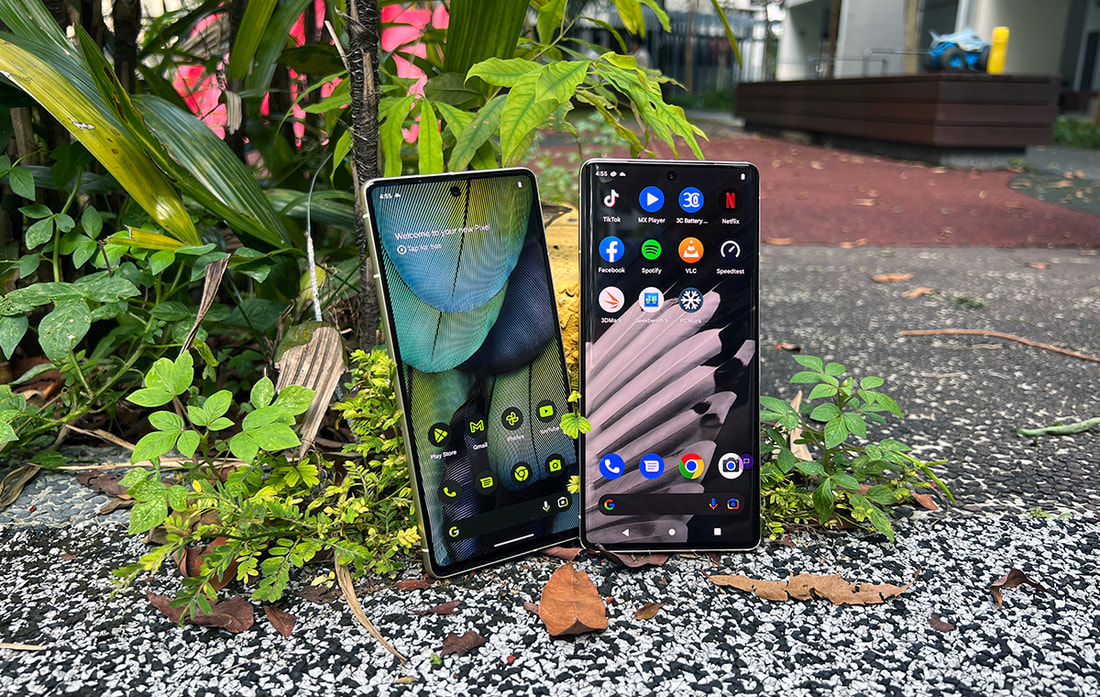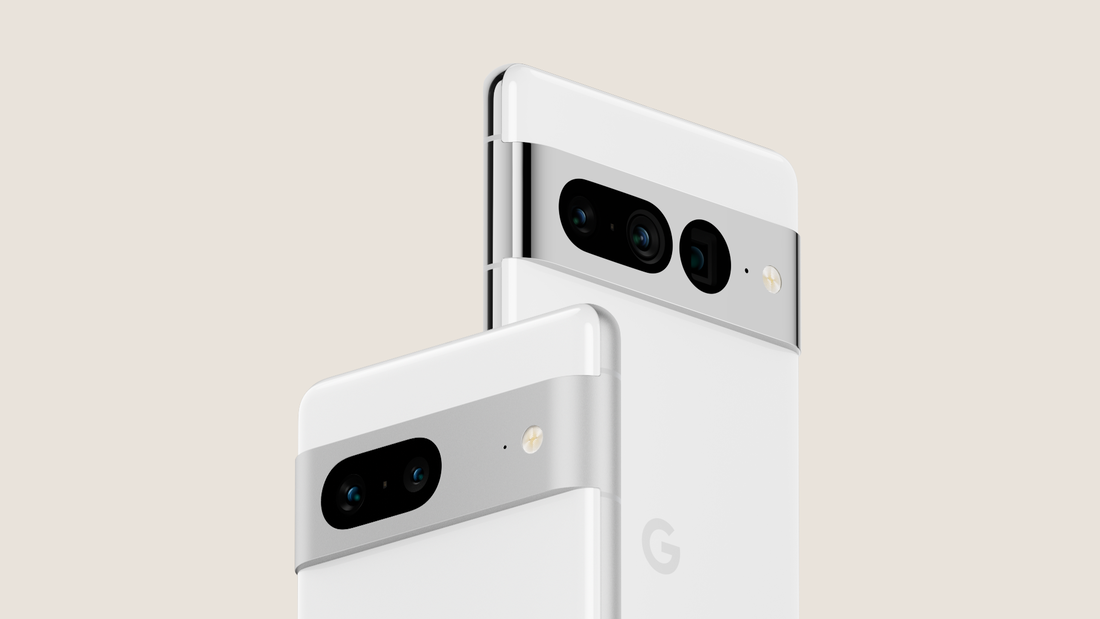|
Google fully revealed the Pixel 7 Pro and Pixel 7 during an event on 6 October following several months of teasers.
The two devices succeed the excellent Pixel 6 Pro and Pixel 6, bringing several updates in hardware, a refined design and some exciting new features. If you're wondering what the differences are between the Pixel 7 Pro and the Pixel 7 and which you should buy, we have you covered. Here is how the Pixel 7 Pro and the Pixel 7 compare to help you work out which is the right one for you.
Price
The Google Pixel 7 starts at SGD $999 - the same as the Pixel 6, while the Pixel 7 Pro starts at SGD $1,299 - again the same as the Pixel 6 Pro. The Pixel 7 Pro is therefore quite a bit more expensive than the standard Pixel 7, though there are a number of reasons for that, which we will take you through below. Design The Google Pixel 7 Pro and Pixel 7 share a similar design, with both offering a camera housing on the rear that spans the width of the devices, just like the Pixel 6 and Pixel 6 Pro. The design has been refined since the Pixel 6 and 6 Pro, but on the whole, it's familiar. There's a premium finish on both the Pixel 7 Pro and Pixel 7, and both offer an IP68 water and dust resistance. The Pixel 7 Pro has a polished aluminium frame, while the Pixel 7 has a matte frame, though both offer Corning Gorilla Glass Victus cover glass and edgeless Corning Gorilla Glass Victus rears. The Pixel 7 Pro is the larger and heavier of the two devices, and though both come in Snow (white) and Obsidian (black) colour options, the third colour variant differs with the Pixel 7 coming in Lemongrass and the 7 Pro in Hazel. Unlike the Pixel 6 Pro and Pixel 6, the rear isn't two-toned. On the front, both the Pixel 7 Pro and the Pixel 7 have a punch hole camera at the top of their displays in the centre, though the Pixel 7 Pro has a slightly curved display, while the Pixel 7 offers a flat display. Both have under-display fingerprint sensors and they both come with Face Unlock.
Display
The Google Pixel 7 Pro comes with a 6.7-inch LTPO OLED display with a refresh rate up to 120Hz. It offers a Quad HD+ resolution (3120 x 1440), which delivers a pixel density of 512ppi, which is the same as the Pixel 6 Pro. The Pixel 7 meanwhile, has a 6.3-inch display, which is also an OLED panel, though not LTPO. It has a Full HD+ resolution (2400 x 1080) for a pixel density of 416ppi and there's a 90Hz refresh rate. That means the Pixel 7 Pro will be the sharper display and offer smoother scrolling, though you may not notice unless you had both side-by-side. As mentioned, the Pixel 7 Pro has a slightly curved display, while the Pixel 7 has a flat display. The Pixel 7 Pro and Pixel 7 have slightly brighter displays than their predecessors too, with a peak brightness of 1500nits for the Pixel 7 Pro and 1400bits for the Pixel 7. HDR support is also present on both. Hardware and specs Both the Google Pixel 7 Pro and the Pixel 7 run on the next generation of the Google Tensor chip, which is called Google Tensor G2. The chip offers more power for photos, video, security and speech recognition. The Titan M2 security chip is also on board both devices. The Pixel 7 Pro comes with 12GB of RAM compared to the Pixel 7's 8GB of RAM though. Storage options are 128GB and 256GB for the Pixel 7, while the Pixel 7 Pro adds a 512GB variant. Neither the Pixel 7 or 7 Pro offer microSD support for storage expansion. In terms of battery capacities, the Pixel 7 Pro offers a 5000mAh call again, like the Pixel 6 Pro, while the Pixel 7 has a 4355mAh battery under its hood. Both have fast charging on board, offering up to 50 per cent charge in 30 minutes, and they both have wireless charging and Battery Share, which is also known as reverse wireless charging.
Camera
Aside from physical size and a couple design details, the biggest difference between the Pixel 7 Pro and the Pixel 7 is in their camera offerings. The Pixel 7 Pro has a triple rear camera, while the Pixel 7 has a dual camera. The Pixel 7 Pro's triple rear camera consists of a 48-megapixel telephoto lens (f/3.5, 0.7µm) with 5x optical zoom capabilities, a 50-megapixel main sensor (f/1.85, 1.2µm) with an 82-degree field of view and a 12-megapixel ultra wide sensor (f/2.2, 1.25µm) with a 125.8-degree field of view. The Pixel 7's camera has the same main sensor and ultra wide sensor as the Pixel 7 Pro, but it doesn't offer the telephoto lens. Both devices have features including Motion Mode, Real Tone, Photo Unblur and Magic Eraser, as well as the company's excellent Night Sight. The Pixel 7 Pro also offers Macro Focus and 30x high resolution zoom, while the Pixel 7 doesn't have the Macro Focus feature and it's high resolution zoom tops out at 8x. Both the Pixel 7 Pro and the Pixel 7 have a 10.8-megapixel front camera (f/2.2, 1.22µm) with 4K video recording. Conclusion The Google Pixel 7 Pro and Pixel 7 both have a similar design, with a couple of differences, including the rear camera, physical size and colour variations. The Pixel 7 Pro also offers a slightly curved display compared to the Pixel 7's flat display, as well as a sharper resolution, higher refresh rate, more RAM, more storage and a larger battery. It is the camera offerings where the biggest difference between these two devices is the most apparent though, with the Pixel 7 Pro offering a telephoto sensor and some extra camera features, like Macro focus and a higher resolution zoom. The Pixel 7 Pro is the more expensive of these two devices though, so the decision as to which is right for you will very much depend on what features are important to you and what you're willing to pay for them. The Pixel 7 will likely be a very capable device, but the Pixel 7 Pro will bring those luxury extras and it's the one to buy between these two models if you can justify the cost.  ✅ Rakuten Kobo Nia, Clara Color, Libra Color, Sage, Elipsa 2E + Above Freebies
SGD 179.99 - SGD 699.99
✅ Ledger Authentic Nano X, (New) Nano S+ & Nano S Crypto Wallet + Above Freebies
SGD 149.99 - SGD 219.99
✅ GeekBite Amazon Kindle Basic and Kids 2022 with backlight (Latest)
SGD 209.99 - SGD 229.99
Only a few left! ✅ GeekBite Fitbit Sense 2, Versa 4, Charge 5, Luxe, Inspire 3. Fitbit SG Authorized Retailer. 12 Months Warranty
SGD 145.99 - SGD 399.99
Comments are closed.
|





